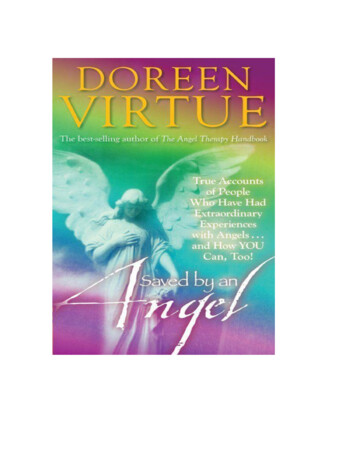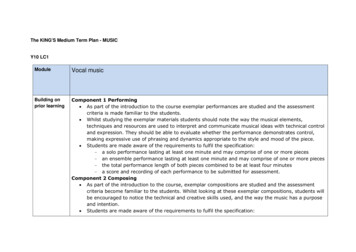
Transcription
Killer Angel
Killer AngelA Biography of Planned Parenthood'sFounder Margaret SangerGeorge GrantArs Vitae PressFranklin, TennesseeandThe Reformer LibraryNew York, New York
1995by George GrantAll rights reservedPrinted in the United States of AmericaUnless otherwise noted, all Scripture quotations are from theHoly Bible, New King James Version, 1982 by Thomas Nelson, Inc.ISBN 1-887690-026Cover Photo: BettmannArs Vitae Press, a ministry of the King's Meadow StudyCenter, has been established to help equip Christians withthe necessary tools to do justice, to love mercy, and towalk humbly in accord with the good providence of God(Micah 6:8).For more information about this ministry, write us at:P. O. Box 1601, Franklin, Tennessee 37065
To Susan Hunt,Angel ofHopeandKaren Grant,Angel ofLife
CONTENTSAcknowledgmentsIntroductionPart One: Still Life1. Root of Bitterness / 112. The Winter of Her Discontent / 17Part Two: Whence? What? Whither?3. The Woman Rebel /274. Madonna /33Part Three: No Little People5. Arrested Development / 436. Babylonian Exile / 49Part Four: The End of Man7. Sex Education /618. Human Weeds /69Part Five: To Be or Not to Be9. A New World Order /7910. The Marrying Kind /89Part Six: How Should We Then Live?11. Root and Fruit / 10112. The Big Lie / 107Notes / 111
ACKNOWLEDGMENTSI am riding my pen on the shuffle, andit has a mouth ofiron.G. K. Chesterton lHILAIRE BELLOC) PERHAPS THE MOST PROLIFICcurmudgeon of this century) once quipped)"There is something odd book writers do in theirprefaces) which is to introduce a mass of nincompoops ofwhom no one has ever heard) and. say) my thanks is due tosuch and such) all in a litany) as though anyone cared afarthing for the rats.))2Needless to say) Belloc did not place high stock ineither gratitude or accountability. His fierce self-assurance and autonomy as an author was defiantly unflappable. I would hope that I know better.A number of friends and fellow-laborers encouragedme to pursue this project-and at the same time helped tosupport the work of the King's Meadow Study Center sothat I could. David and Pam Ferriss) Mike and DebbieGrimnes) Jerry and Cindy Walton) Steve and MarijeanGreen) Bill and Robin Amos, Bill and Sharon Taylor) Jimand Gwen Smith) John and Marye Lou Mauldin) Steve andKaren Anderson) and Bill and Dawn Ruff have all beenselfless supporters from the beginning. Dale and Annix
Smith, Stephen and Trish Mansfield, Steve and WendyWilkins, Gene and Susan Hunt, Tom and Yo Clark, andDavid and Diane Vaughan guided me through many arocky shoal with their wise counsel and friendship.Mike Hyatt first suggested that I consider turning mywriting proclivities toward biographies. Jan Dennis,David Dunham, Jim Bell, and Dean Andreola gave memy first opportunities to try my hand at this ratherdemanding art. Randy Terry suggested. this particularproject. And Otto Scott pointed the way for me byproviding the appropriate models from which to learn.Michael Schwartz, Jim Sedlak, Patricia Bainbridge,and Doug Scott are among the finest thinkers, writers,and researchers in the area of Planned Parenthood,Margaret Sanger, and the abortion issue. Each has beenamazingly gracious and kind to me in sharing theirinsights, resources, and information.The soundtrack for this project was provided byLoreena McKennitt, Clannad, Mychael Danna, and JeffJohnson while the midnight musings were provided byJohn Buchan, Colin Thubron, Samuel Johnson, and, ofcourse, G.K. Chesterton.To all these, I offer my sincerest thanks.I probably ought to mention as well the Nine Muses,the Three Graces, and the Merry Band ofJoyeuse Garde,but the fact is my greatest and best inspiration comesfrom my family. Karen is without a doubt a «help meet"for me. And Joel, Joanna, and Jesse are the pride of mylife. Their love and unwavering faithfulness remain mygreatest hope and richest resource. To them lowe myall in all.King's Meadow Farm, Eastertide 1995x
INTRODUCTIONFor all the apparent materialism and mass mechanismofour present culture, we, far more than any ofourfathers, live in a world ofshadows.G. K. ChestertonO1N JANUARY I, 1900 , MOST AMERICANS GREETEDthe twentieth century with the proud and certain belief that the next hundred years wouldbe the greatest, the most glorious, and the most glamorous in human history. They were infected with a sanguine spirit. Optimism was rampant. A brazenconfidence colored their every activity.Certainly there was nothing in their experience tomake them think otherwise. Never had a centurychanged the lives of men and women more dramaticallythan the nineteenth one just past. The twentieth centuryhas moved fast and furiously, so that those of us whohave lived in it feel sometimes giddy, watching it spin;but the nineteenth moved faster and more furiously still.Railroads, telephones, the telegraph, electricity, massproduction, forged steel, automobiles, and countlessother modern discoveries had all come upon them at a1
KILLER ANGELdizzying pace, expanding their visions and expectationsfar beyond their grandfathers' wildest dreams.It was more than unfounded imagination, then, thatlay behind the New York World's New Year's predictionthat the twentieth century would «meet and overcomeall perils and prove to be the best that this steadily. p Ianet has ever seen. ,,2ImprovIngMost Americans were cheerfully assured that controlof man and nature would soon lie entirely within theirgrasp and would bestow upon them the unfathomablemillennial power to alter the destinies of societies, nations' and epochs. They were a people of manifold purpose. They were a people of manifest destiny.What they did not know was that dark and malignant seeds were already germinating just beneath thesurface of the new century's soil. Josef Stalin was atwenty-one-year-old seminary student in Tiflis, a piousand serene community at the crossroads ofGeorgia andUkraine. Benito Mussolini was a seventeen-year-oldstudent teacher in the quiet suburbs of Milan. AdolfHitler was an eleven-year-old aspiring art student in thequaint upper Austrian village ofBrannan. And MargaretSanger was a twenty-year-old out-of-sorts nursingschool dropout in White Plains, New York. Who couldhave ever guessed on that ebulliently auspicious NewYear's Day that those four youngsters would, over thespan ofthe next century, spill more innocent blood thanall the murderers, warlords, and tyrants of past historycombined? Who could have ever guessed that those fouryoungsters would together ensure that the hopes anddreams and aspirations of the twentieth century wouldbe smothered under the weight of holocaust, genocide,and carnage?2
INTRODUCTIONAs the champion of the proletariat, Stalin saw to theslaughter of at least fifteen million Russian and Ukrainian kulaks. As the popularly acclaimed II Duce, Mussolini massacred as many as four million Ethiopians,two million Eritreans, and a million Serbs, Croats, andAlbanians. As the wildly lionized Fahrer, Hitler exterminated more than six million Jews, two million Slavs, anda million Poles. As the founder of Planned Parenthoodand the impassioned heroine of various feminist causescelebres, Sanger was responsible for the brutal elimination of more than thirty million children in the UnitedStates and as many as two and a half billion worldwide.No one in his right mind would want to rehabilitatethe reputations of Stalin, Mussolini, or Hitler. Theirbarbarism, treachery, and debauchery will make theirnames live in infamy forever. Amazingly though, Sangerhas somehow escaped their wretched fate. In spite of thefact that her crimes against humanity were no less heinous than theirs, her place in history has effectively beensanitized and sanctified. In spite of the fact that sheopenly identified herself in one way or another withtheir aims, intentions, ideologies, and movementswith Stalin's Sobornostic Collectivism, with Hitler'sEugenic Racism, and with Mussolini's AgathisticFacism-her faithful minions have managed to manufacture an independent reputation for the perpetuationof her memory.In life and death, the progenitor of the grisly abortion industry and the patron of the devastating sexualrevolution has been lauded as a ((radiant" and ((courageous" reformer. 3 She has been heralded by friend andfoe alike as a ((heroine," a ((champion," a ((saint," and a((martyr.,,4 Honored by men as different and divergent3
KILLER ANGELas H. G. Wells and Martin Luther King, George BernardShaw and Harry Truman, Bertrand Russell and John D.Rockefeller, Albert Einstein and Dwight Eisenhower,this remarkable «killer angel" was able to secret away herperverse atrocities, emerging in the annals of historypractically vindicated and victorious. 5That this could happen is a scandal of grotesqueproportions.And recently the proportions have only grown-likea deleterious kudzu or a rogue Topsy. Sanger has beenthe subject ofadoring television dramas, hagiographicalbiographies, patronizing theatrical productions, andsaccharined musical tributes. Though the facts ofher lifeand work are anything but inspiring, millions of unwarymoderns have been urged to find in them inspirationand hope. Myth is rarely dependent upon truth, after all.Sanger's rehabilitation has depended on writers,journalists, historians, social scientists, and sundryother media celebrities steadfastly obscuring or blithelyignoring what she did, what she said, and what shebelieved. It has thus depended upon a don't-confuseme-with-the-facts ideological tenacity unmatched byany but the most extreme of our modern secular cults.This brief monograph is an attempt to set the recordstraight. It is an attempt to rectify that shameful distortion of the social, cultural, and historical record. It hasno other agenda than to replace fiction with fact.Nevertheless, that agenda necessarily involves stripping away all too many layers of dense palimpsests ofpolitically correct revisionism. But that ought to be thehonest historian's central purpose anyway. Henry CabotLodge once asserted: «Nearly all the historical workworth doing at the present moment in the English lan-4
INTRODUCTIONguage is the work of shoveling off heaps of rubbishinherited from the immediate past.,,6That then is the task of this book.Ofcourse, many would question the relevance ofanykind of biographical or historical work at all. I cannoteven begin to recount how many times a Planned Parenthood staffer has tried to deflect the impact ofSanger's heinous record by dismissing it as «old news»or «ancient history" and thus irrelevant to any currentissue or discussion. It is an argument that seems to sellwell in the current marketplace of ideas. We have actually come to believe that matters and persons of presentimport are unaffected by matters and persons of pastimport.We moderns hold to a strangely disjunctive view ofthe relationship between life and work-thus enablingus to nonchalantly separate a person's private characterfrom his or her public accomplishments. But this noveldivorce of root from fruit, however genteel, is a ribalddenial of one of the most basic truths in life: what youare begets what you do; wrong-headed philosophiesstem from wrong-headed philosophers; sin does not justhappen-it is sinners that sin.Thus, according to the English historian and journalist Hilaire BeHoc, «Biography always affords thegreatest insights into sociology. To comprehend thehistory ofa thing is to unlock the mysteries ofits presen and more, to discover the profundities of its future."Similarly, the inimitable Samuel Johnson quipped, «Almost all the miseries of life, almost all the wickednessthat infects society, and almost all the distresses thatafflict mankind, are the consequences of some defect in5
KILLER ANGELprivate duties.,,8 Or) as E. Michael Jones has asserted)((Biography is destiny.,,9This is particularly true in the case of MargaretSanger. The organization she founded) Planned Parenthood) is the oldest) largest) and best-organized provider10of abortion and birth control services in the world.From its ignoble beginnings around the turn of thecentury) when the entire shoestring operation consistedofan illegal back-alley clinic in a shabby Brooklyn neighborhood staffed by a shadowy clutch of firebrand activists and anarchists) 11 it has expanded dramatically intoa multi-billion-dollar international conglomerate withprograms and activities in 134 nations on every continent. In the United States alone) it has mobilized morethan 20)000 staff personnel and volunteers along thefront lines of an increasingly confrontational and vitriolic culture war. Today they handle the organization)s167 affiliates and its 922 clinics in virtually every major' an opuIent· area) coast to coast. 12 Bmetropo1Itanoastlngnational headquarters in New York) a sedulous legislative center in Washington) opprobrious regional command posts in Atlanta) Chicago) Miami) and SanFrancisco) and officious international centers in London) Nairobi) Bangkok) and New Dehli) the Federationshowed 23.5 million in earnings during fiscal year1992) with 192.9 million in cash reserves and another13 108.2 million in capital assets. With an estimatedcombined annual budget-including all regional andinternational service affiliates--of more than a billiondollars) Planned Parenthood may well be the largest and. . .In h'IstOry. 14most pro fiItabie non-pro fiIt organizationThe organization has used its considerable political)institutional) and financial clout to mainstream old-6
INTRODUCTIONschool left-wing extremism. It has weighed in with sophistocated lobbying, advertising, and back-roomstrong-arming to virtually remove the millennium-longstigma against child-killing abortion procedures andfamily-sundering socialization programs. Planned Parenthood thus looms like a Goliath over the increasinglytragic culture war.Despite its leviathan proportions it is impossible toentirely understand Planned Parenthood's policies,programs, and priorities apart from Margaret Sanger'slife and work. It was, after all, originally established tobe little more than an extension of her life and world.15VIew.Most of the material from this project has beendrawn from research that I originally conducted for twocomprehensive exposes of that vast institutional cashcow. Entitled Grand Illusions: The Legacy of PlannedParenthood, the first book has gone through twelveprintintfs and two editions since it was first published in11988. The second book, entitled Immaculate Deception: The Shifting Agenda ofPlanned Parenthood, detailsthe remarkable changes the organization has made overthe last decade. I ? They gave wide exposure to the tragicproportions of Sanger's saga. From the beginning ofthose massive projects, though, I felt that a shorter andmore carefully focused biographical treatment was warranted. Little has changed in the interim---except thatthe monolithic reputations of Sanger and her frighteningly dystopic organization have only been further enhanced.It is therefore long overdue that the truth be told. Itis long overdue that the proper standing of Margaret?
KILLER ANGELSanger in the sordid history of this bloody century besecured. To that end, this book is written.You cannot help but notice, however, that it is adeliberately abbreviated tome-especially when it iscompared to the breadth and depth of its wellspring,Grand Illusions and Immaculate Deception. Unpleasantries need to be accurately portrayed, but they need notbe belabored. Caveats ought to be precise and to thepoint. Corrective counterblasts ought to be painstakingly careful, never crossing the all too fine line betweeninforming and defiling the minds of readers.Just as brevity and purpose are the heart and soul ofwit, so they are the crux and culmination of true understanding. In light of this, it is my sincere prayer that trueunderstanding will indeed be the end result of this briefbut passionate effort.Deus Vult.8
PART ONESTILL LIFEWe perpetually come back to that sharp andshining point which the modern world isperpetually trying to avoid. We must havea creed, even in order to be comprehensive.--G. K. Chesterton 1
1ROOT OF BITTERNESSHappy is he who not only knows the causes ofthings,but who has not lost touch with their beginnings.--G. K. Chesterton 2MARGARET SANGER WAS BORN ON SEPTEMBER14,1879, in the small industrial community ofCorning in upstate New York, the sixth ofeleven children. The circumstances of her home lifewere never happy-a fact to which she later attributedmuch of her agitated activism and bitter bombast. If itis true that "The hand that rocks the cradle rules theworld," it is equally true that "The hand that wrecks thecradle ruins the world.,,3Her father, Michael Higgins, was an Irish Catholicimmigrant who fancied himselfa radical freethinker anda free-wheeling skeptic. As a youngster he had enlistedin General William Sherman's notorious Twelfth New11
KILLER ANGELYork Cavalry and proudly participated in the nefariouscampaign that ravaged and ravished the South) acrossTennessee) through Atlanta) and to the sea. He achievednotable infamy among his peers when he was honoredby his commander for special treachery in fiercely subduing the recalcitrant captive population. Not surprisingly) that cruel and inhuman experience apparentlyhardened and embittered him. Triage and genocide arenot easily forgotten by either victims or perpetrators.His criminal inhumanity constituted a kind of spiritualcalamity from which he) like so many others of hisregion) never fully recovered. Forever afterward he waspathetically stunted) unable to maintain even a modicum of normalcy in his life or relations.He worked sporadically as a stone mason and atombstone carver but was either unwilling or unable toprovide adequately for his large family. Margaret'smother) Anne Purcell) was a second-generation American from a strict Irish Catholic family. She was frail andtuberculous but utterly devoted to her unstable andunpredictable husband-as well as to their ever-growing brood of children.The family suffered bitterly from cold) privation)and hunger. That was the common lot of thousands ofother families in nineteenth-century America. But theHigginses also suffered grievously from scorn) shame)and isolation because ofMichael's sullen improvidence.And like many a man who is proudly progressive inpublic) he was repressively remonstrant at home. Heregularly thrashed his sons "to make men of them.,,4And he treated his wife and daughters as "virtualslaves.,,5 And when he drank-which was whenever he12
ROOT OF BITTERNESScould afford it-his volatile presence was even moreoppressive than normal.That is the paradox of dogmatic liberalism: thoughit loudly declares itself a champion of the weak, it isactually an unrelenting truncheon of the strong. Ideology inevitably resolves itself in some form of tyranny.Sanger later described her family's existence underthe unenlightened and inhuman hand of Michael's enlightened humanism as "joyless and filled with drudgeryand fear.,,6 Even as an adult, whenever she was on a trainthat merely rode through Corning, she got a sharp painin the pit of her stomach. She suffered, she said, from«Corningitis.,,7Clearly, the Higginses had an impoverished and isolated life; but, not only did they have to endure gravesocial and material lack, they were spiritually deprivedas well. As a confirmed skeptic, Michael mocked thesincere religious devotion of most of his neighbors. Heopenly embraced radicalism, socialism, and atheism.And he had little toleration for the modicum ofmoralitythat his poor wife tried to instill in the lives of theirhapless children.One day, for example, when Margaret was on herknees saying the Lord's Prayer, she came to the phrase«Give us this day our daily bread," and her father snidelycut her off."Who were you talking to?" he demanded."To God," she replied innocently."Well, tell me, is God a baker?"With no little consternation, she said, «No, of coursenot. But He makes the rain, the sunshine, and all thethings that ma e the wheat, which makes the bread."13
KILLER ANGELAfter a thoughtful pause her father rejoined, «Well,well, so that's the idea. Then why didn't you just say so?Always say what you mean, my daughter, it is much,,8better.In spite of Michael's concerted efforts to undermineMargaret's young and fragile faith, her mother had herbaptized in St. Mary's Catholic Church on March 23,1893. The following year, on July 8, 1894, she was confirmed. Both ceremonies were held in secret-her fatherwould have been furious had he known. For some timeafterward she displayed a zealous devotion to spiritualthings. She regularly attended services and observed thedisciplines of the liturgical year. She demonstrated abudding and apparently authentic hunger for truth.But gradually the smothering effects of Michael'scynicism took their toll. When her mother died underthe strain of her unhappy privation, Margaret was morevulnerable than ever before to his fierce undermining.Bitter, lonely, and grief-stricken, by the time she wasseventeen her passion for Christ had collapsed into abitter hatred of the church. This malignant malevolencewould forever after be her spiritual hallmark.Anxious to move away from home as soon as shecould, Margaret was willing to go anywhere and tryanything-as long as it was far from Corning. After aquick, almost frantic search, she settled on ClaverackCollege. A small and inexpensive co-educational boarding school attached to the famed Hudson River Institute' Claverack was a Methodist high school housed inan imposing wooden building on twenty picturesqueacres overlooking the Hudson Valley. Not known for itsacademic rigors, the school was essentially a finishingschool for protean youth.14
ROOT OF BITTERNESSThere at Claverack Margaret got her first taste offreedom. And what a wild and intoxicating freedom itwas. She plunged into radical politics) suffragette feminism) and unfettered sex. Despite her relatively lightacademic load) she quickly fell behind in her work. Sherarely attended her classes. And she almost never completed her assignments. Worse) she neglected her parttime job-necessary to pay for the nominal tuition.It is said that we become most like those whom weare bitter against. Despite her now obvious animositytoward him) Margaret began to unconsciously emulateher father)s erratic personality. The stronger her resistance to his influence grew) the greater her imitation ofhis improvidence became.Character has consequences. When she could nolonger afford the tuition at Claverack) she was forced toreturn home-but only long enough to gather her belongings and set her affairs in order. She had drunk fromthe cup of concupiscence and would never again besatisfied with the quiet responsibilities and virtues ofdomesticity. And so) as soon as she could) she moved inwith her older sister in White Plains) taking a job as akindergarten teacher.A youth corrupted became a youth corruptor. Sinceshe herself was now a high school dropout) she wasassigned to a class made up primarily of the children ofnew immigrants. Much to her dismay) she found thather pupils could not understand a word that she said.She quickly grew tired ofthe laborious routine ofteaching day in and day out. Gratefully) she quit after just twoshort terms.Next) she applied for a job as a nurse-probationer ata small local hospital. Again) though) Margaret's careless15
KILLER ANGELand nomadic rootlessness was telling. Hospital workproved to be even more vexing and taxing than teaching.She never finished her training. In later years, however,she would claim to be a trained and practiced nurse.Nearly forty pages of her Autobiography were devoted toher varied, often heroic, experiences as a seasoned veteran in professional health care. 9 But they were littlemore than Margaret's well-realized fantasies.In fact, her actual exposure to medicine was almostnonexistent: she never got beyond running errands,changing sheets, and emptying bedpans. Like so muchelse in the mythic fable of her rise to prominence, hercareer as a nurse was little more than perpetrated fraud.Determined to escape from the harsh bondage oflabor and industry, she once again began to cast aboutfor some viable alternative. She finally resorted to theonly viable course open to a poor girl in those seeminglyunenlightened days when the Puritan work ethic wasstill ethical: she married into money.16
2THE WINTER OF HERDISCONTENTThe special mark ofthe modern world is not that it isskeptical, but that it is dogmatic without knowing it.-G. K. Chesterton lWILLIAM SANGER WAS NOT EXACTLY RICH,but he was financially secure--and that wasclose enough for Margaret. He was a youngman of great promise. An up-and-coming architectwith the famed McKim, Mead, and White firm in NewYork City) he had already made a name for himselfwhile working on the plans for the resplendant GrandCentral Station and the landmark Woolworth towerin midtown Manhattan.17
KILLER ANGELHe met Margaret at a party in White Plains in 1900and immediately fell head over heels in love. He was atall, dark-haired man with intense coal-black eyes anda thin-set mouth turned down like an eagle's. Nowalmost thirty and entirely dedicated to his work, hehad sorely neglected the social side ofhis life for severalyears. But he was smitten by the girlishly slim, redheaded beauty he met that day.He courted Margaret with a single-minded zeal,promising her devotion, leisure, and a beautifulhome-the fulfillment of her most cherished dreams.He plied her affections with flowers, candy, jewelry,and unremitting attention. As for her part, she waswillingly-even enthusiastically--courted.Within just a few months they were married.The Sangers settled into a pleasant apartment inManhattan's Upper East Side and set up housekeeping. But housekeeping appealed to Margaret even lessthan teaching or nursing. Though she busied herselfcollecting pots, pans, and dishes, she quickly grewrestless and sullen.Her doting husband tried everything he couldthink of in a determined effort to satisfy her restlessand unresolved passions. He sent her off for longvacations in the Adirondacks. He hired maids andattendants. He bought her expensive presents. Heeven designed and built an extravagant home in theexclusive Long Island suburbs. Nothing seemed to suithis temperamental bride.In short order they had three children, two boysand a girl. Like so many before and since, Margaretthought that having babies might bring her the fulfill-18
THE WINTER OF HER DISCONTENTment she so longed for; however, raising children isnot exactly a hobby to be taken on a whim by thediscontented. It is a responsible commitment requiring diligence, long-suffering, and hard work.Margaret had never been one to apply herself tosuch disciplines. Alas, even her children proved to bebut temporary diversions.Once again, she demonstrated the telling truth ofthe tired truism: like father, like daughter.After nearly a decade of undefined domestic dissatisfaction, she convinced William to sell all they had,including their comfortable suburban estate, andmove back into the brusque and cosmopolitan Manhattan hubbub. There she quickly threw herself intothe fast-paced social life of the city: shopping, dining,reveling, and theater-going. She attempted to drownher rootless discontent in the wastrel champagne ofimprovidence.Meanwhile, William began to renew old ties inradical politics by attending Socialist, Anarchist, andCommunist meetings down in Greenwich Village. Before he wooed Margaret, he had toyed with adolescentnotions of political millenarianism and socialutopianism from time to time. With his wife distracted by her material quest and his work no longeran all-consuming passion, he once again explored thenether realm of coercive idealism.At the time, New York was well on its way tobecoming a seething cauldron of radical ideas andsocial unrest. The syndicalist notions ofthe early labormovement, the libertarian ideas ofthe early suffragettemovement, and the proletarian notions of the early19
KILLER ANGELprogressive movement made for a heady culturalbrew. And William drank from it deeply. He threw inhis lot with a myriad of extremist groups, fringe coalitions, and perennial lost causes.Though she generally eschewed the smoke-filledrooms and the fervid rhetoric of his radical associations, from time to time-usually when she bored ofher more patrician activities-Margaret would tagalong with William to sundry rallies, caucuses, andprotests. Though his sense of justice and social ireseemed perpetually roused to a fever pitch, she remained supremely unimpressed. In fact, she oftenmocked the rag-tag revolutionaries as the comical andmotley crew that they were. She described Bill Haywood, founder of the left-wing Industrial Workers ofthe World, as «an uncouth, stumbling, one-eyed giantwith an enormous head.,,2 She said that AlexanderBeckman, another perenially hapless labor organizerfrom the radical fringe, was essentially" a hack, armchair socialist-full of hot air, but likely little else.,,3She called Eugene Debs a "silly silk hat radical.,,4 Andshe characterized the partisans of the Socialist Party as"losers, complainers, and perpetual victims-unwilling or unable to do for themselves, much less for. at 1arge. ,,5socIetyOne evening, however, she heard a radical labororganizer describe the pitiful working conditions ofthe many sweatshops and chattel dens throughoutNew York's Lower West Side and the Midtown Garment District. But it was not the image ofsuffering andinjustice that arrested her attentions--she had heardall that before. It was the speaker's vision of the power20
THE WINTER OF HER DISCONTENTofwell-planned social subversion and disruptive antiestablishment protest that gripped her.John Reed, who would later gain fame as a propagandist for the Bolsheviks in Soviet Russia, was apassionate speaker who exu
KILLER ANGEL as H. G. Wells andMartinLutherKing, George Bernard ShawandHarryTruman,BertrandRussell andJohnD. Rockefeller, Albert Einstein and Dwight Eisenhower, thisremarkable«killer angel"was abletosecretawayher perverse atrocities, emerging in the annals of history practicall










